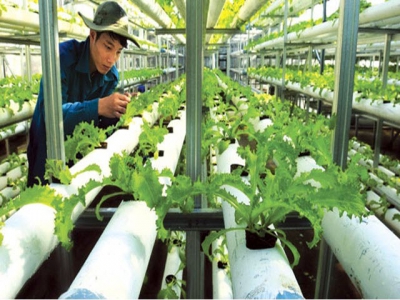Boosting modern agriculture aligned with building new-style rural areas

Vietnam will promote hi-tech, ecological and organic agriculture (illustrative image)
2018 marked the 10-year implementation of Resolution No.26 of the 10th Party Central Committee's 7th session on agriculture, farmers and rural areas with considerable achievements, opening up a new period of developing a modern and sustainable agricultural sector, in line with building new-style rural areas and enhancing the living standards of rural residents, said Minister of Agriculture and Rural Development Nguyen Xuan Cuong.
Minister Cuong said that, over the past decade, the agricultural production structure has been adjusted and shifted to promoting the advantages of each locality in connection with the market demand. The average GDP growth rate of the whole agricultural, forestry and aquatic sector was reported at 2.66% per year and the sector's production value growth rate reached 3.9% per year in the 2008-2017 period. In 2018, the sector's GDP growth rate is estimated at 3.6% - 3.7%.
Agricultural labour productivity has improved, rising from VND13.6 million (US$584.8) per labourer in 2008 to VND35.5 million (US$1,526) per labourer in 2017. The agricultural production value also increased from VND43.9 million (US$1,887) per ha in 2008 to VND90.1 million (US$3,874) per ha in 2017.
Vietnamese agricultural products have been present in over 180 countries and territories worldwide, with the export revenue ranked second in Southeast Asia and 15th in the world. Vietnam's total agricultural export turnover in the 10 years reached more than US$261 billion, including US$36.5 billion worth of agricultural, forestry and aquatic exports in 2017, up 2.2 times compared to 2008. This year's agricultural, forestry and aquatic export revenue is expected to hit over US$40 billion.
Vietnam also witnessed 10 groups of goods with an annual export turnover of over US$1 billion, including five items posting export turnover of over US$3 billion each.
The income per capita in rural areas has increased by 3.49 times from VND9.15 million (US$393.4) in 2008 to VND32 million (US$1,376) in 2017, while the income gap between urban and rural areas has narrowed to 2.1 times in 2008 and to 1.8 times in 2017. The average rate of poor households has decreased by 1.5% per year and by 4% per year in extremely poor districts.
In addition, the national forest coverage has increased sharply from 38.7% in 2008 to 41.45% in 2017 and 41.65% in 2018.
By November 2018, the country had 3,687 communes meeting the criteria set for new-style rural areas, accounting for 41.32% of the total number of communes and 58 districts were recognised as completing the task of building new-style rural areas.
The new-style rural areas programme has helped 99.2% of rural households to gain access to electricity, while 99.7% of communes have primary schools and kindergartens, 99.5% of communes have health stations and 88.5% of the rural population has access to clean water.
Besides the remarkable achievements, Minister Cuong also pointed out inadequacies in the implementation of Resolution No.26 regarding the quality, efficiency and sustainability of agricultural production, the rural economy and the building of new-style rural areas.
The agricultural growth rate was lower than the target of 3.5%-4% set out in the Resolution for many years. The agriculture sector mainly relies on smallholder farmers lacking links and being vulnerable to market fluctuations, natural disasters and epidemics. Meanwhile, the quality and competitiveness of many types of agricultural products are not high, in addition to shortcomings in the management of food safety and hygiene.
Rural infrastructure, particularly transport, irrigation, and electricity works, has yet to meet the requirement of large-scale agricultural commodity production.
The income and living standards of a majority of farmers remain low with the average income of farmers equivalent to 78% of the national average.
The poverty reduction results are not sustainable as the rate of households relapsing into poverty accounts for 5.1% of the total number of households escaping from poverty. By the end of 2017, agricultural labour still occupied 40.1% of the total social workforce but the rate is expected to decrease to 38% in 2018.
Speaking at a national teleconference reviewing the 10-year implementation of Resolution No.26, in Hanoi, on November 27, PM Phuc said that it is necessary to "create a revolution in the development of agriculture” to build a modern agricultural sector with high competitiveness and added values, which is capable of adapting to climate change, in addition to improving the living standards of rural residents.
To fulfil the set targets, the agricultural sector should continue to boost its restructuring and building of new-style rural areas. In the 2020-2030 period, roughly 400,000 - 500,000 ha of rice land will be converted into land for livestock, aquaculture, and other types of production with higher efficiency.
In addition, the country will promote hi-tech, ecological and organic agriculture and utilise the achievements of the Industry 4.0 and apply them to agricultural production. Furthermore, traditional craft villages will be further preserved and developed aligned with tourism services.
More preferential policies and credit packages will be developed for enterprises investing in agriculture and rural areas, while farmers will be provided with more vocational training courses to enhance their skills.
It is also advisable to improve the State management over agriculture and rural development so that the sector will gain more considerable achievements in the future, minister Cuong noted.
Related news
 Bayer in private sector alliance to support coffee smallholder farmers
Bayer in private sector alliance to support coffee smallholder farmers Vietnamese smallholder coffee farmers are vulnerable to multiple challenges, from adverse climate impacts to difficulties in accessing inputs and finance
 Đồng Tháp farmers encouraged to grow straw mushroom indoors
Đồng Tháp farmers encouraged to grow straw mushroom indoors Lai Vung District, the largest straw mushroom producer in Đồng Tháp Province, is encouraging farmers to grow the mushroom indoors saying it offers better result
 Dak Lak to reduce coffee-growing area
Dak Lak to reduce coffee-growing area Dak Lak, the country’s largest coffee growing province, plans to reduce the area under the crop from 204,800ha now to 180,000ha by 2030